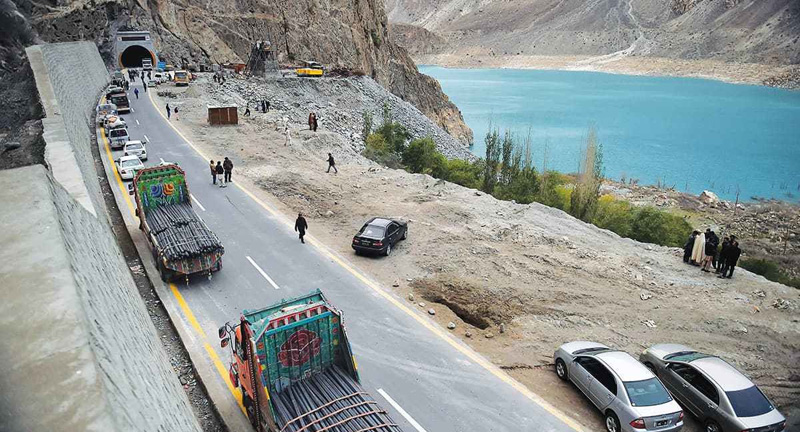
CPEC route to economic and political stability
CPEC is not just a small prospect for Pakistan but has the potential to possibly turn the state into a geo-economically substantial powerhouse in South Asia. China and Pakistan aim for substantially momentous strategic and political gains within the international order towards their benefit with the help of CPEC and the meta-structure of OBOR. Much more than this, the strategic merit of South Asia could be largely heightened because of CPEC. The contemporary situation that persists in Afghanistan, as a result of which all the massive actors have become involved and convoluted in the region, has tied and looped in all the security complexes together. It has put Pakistan at a predisposed position and aggravated its insecurity.
It needs to be implied that the security configuration of Pakistan has now become much more linked to its economic system and CPEC is a pronounced example of this idea as well. Since CPEC is going to be an enterprise that will focus on both security and economics, it inevitably means that advantageously Pakistan will get jauntiness.
But with all of its scale, there are certain trials that Pakistan faces; not just internal but also external in the landscape. To begin with the external vestibule, the biggest challenge for Pakistan is the recognition of the project, which certain other states with an inimical stance are failing to give. Thus, they are repudiating towards CPEC as well as the strategic enterprise of China and Pakistan. This resentment is pre-eminently represented in the dominion of Afghanistan. Additionally in a setting where India has been continuously vexing to push Pakistan into seclusion and the US still has the swindling policy of uncertainty towards the state in lieu of Afghanistan and, in reality, has been able to enhance their “do-more” policy, speaks for itself. Additionally, the concept of unwarranted security and diplomatic relationships with Iran could also manifest in CPEC. In all of this, China requires a suave undertaking of the project without any internal or external instability. And though the military and civilian representatives have reinforced their efforts to restraint terrorism, it appears to be re-developing in terms of some latest events in Lahore, Quetta and now Peshawar.
This tips us to somewhat gradual and raw challenges even for the state. Apart from the revitalisation of terrorism and extremism, the security structure is friable as well as the economic and political one. There is civil-military friction on the horizon and much more than that the non-existence of consistency between political entities, especially affecting CPEC, is a massive issue. Many provincial parties have directed their frameworks towards CPEC and blame the old government for not forming policies, which benefited them all.
Then there is the idea that in the given dynamics of Balochistan and particularly Gwadar, these areas would become the core areas of interests. As a matter of fact, Balochistan is going towards a dim cataclysm in terms of security, strategy, politics and economy. Balochistan and Khyber Pakhtunkhwa are central to the infrastructure of CPEC but both are susceptible in terms of security.
Balochistan specifically is vulnerable not just from some of the Baloch nationalist groups, which are keen to disrupt peace, but also from India, which is working clandestinely to keep the situation in Balochistan very dismantled.
The current attempt brings the dangers of the relegation of Balochis, which could also lead to issues of powerlessness, joblessness, discrimination and material and infrastructure deficiency given the past records of how governments managed Balochistan.
The policy makers play a prominent role in this scenario since they are required to come up with such concepts that deal with all the latent issues without making a mess of the internal and external issues or causing any fissures with Pakistan’s relationship with China. For that reason, the very first thing that needs to be done is the incorporation of the features of the law, which deal with such immense bi-lateral projects in detail. They ought to understand as to what extent Pakistan, and China would have to contribute to the give-and-take of it.
Furthermore, there is also a necessity to make instantaneous and stable efforts to restraint terrorism from not just the North Waziristan Agency but also from Balochistan and Punjab. There need to be education and job opportunities in the quotas for Balochs, KP and other repressed youth so they could disband themselves from any pugnacious groups. Pakistan also needs to articulate constant policies in terms of Gwadar and its strategic, security and economic dynamics.
Lastly, in order to cope with the peripheral threats, Pakistan ought to come up with a comprehensive foreign policy that includes stringent measures to deal with antagonized state behaviour towards itself, which had, in the past, brought massive insecurity and instability within the country. It needs to come up with a framework as to how it deals with India, Iran, Afghanistan as well as the US in terms of CPEC. Perhaps, there is a need to assess the future it can face as well as the past mistakes it made in terms of its foreign policy, jumbling its economic and trade links as well.
The writer is the founder and executive director of Islamabad Institute of Conflict Resolution
